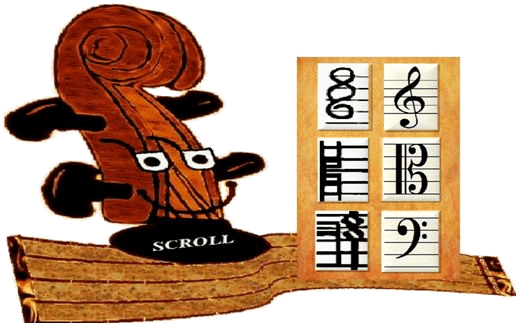
Parts of the Bow and Their Functions
The way in which the bow is held and applied to the strings is directly related to the way the bow is constructed and has evolved.
Centuries of trial and error have gone into the development of bows that we use today.
The evolution of the bow is an excellent display of common sense responses to the increasing demands of music written for string instruments.
The STICK
Wow, Scroll!
Whew! I was sharing the tale of how music clefs originated with another class, so I set my music staff carpet to accelerando and arrived presto! Thanks for inviting me, Q!

You floated by just in time!
Let’s begin now and learn about:

Most often the Bow’s Stick is made of Pernambuco, a hard wood from the region in northern Brazil with the same name. Pernambuco is one of the tightest grain woods on earth. The density of the wood makes it strong and resonant, which is perfect for string instrument bows.
Bows are also made from composites of carbon and fiberglass fibers. Many bows designed for students are made from fiberglass, since they are extremely durable.
The modern day bow is quite different from Baroque bows, which were lighter and more flexible. The arch of the bow also has changed in order to match the demand of the intensity of music in different eras.
Bow-making requires patience and a lot of practice. The bow’s stick is carved and then slowly heated with steam, so that it can be curved. The curving and weighting of the bow’s stick and balance created, is an art form in its own sense.
The better the stick is made, the better the bow’s performance versatility. Bow-makers earn their reputations by entering their finest bows in competitions held world-wide. The stick is the bow’s “back-bone” and gives strength and support to the instrument’s tone.

Introducing the Bow Parts of the Bow The Stick Horse-Hair The Tip The Frog The Winding How the Bow Works
Rosin Preparing to Hold the Bow Stick Training Exercises Bowing Terminology Down-Bow Up-Bow
Bow-Hand Set-Up Finger Tasks and Functions The Thumb Meet ARC Finger Segments The Index-Finger
Bow-Hand Pronation The Center-Finger and Ring-Finger Bow-Hand Fulcrum Ring-Finger Propulsion Bass Bows
Pinky Bow-Tasks ‘Casting’ the Bow-Hand Bow-Wrist Tasks Rotational Inertia Arco Clay Smile Exercise Meet ANGLE
The Bow-Arm Box The Shoulder Arc Bow Contact-Point String Lanes Bow-Segment Mastery Bowing Exercises
Finding the Bow Contact-Point “Painting With Sound” Bowing Exercises Menu Bow Taps Bowing Traditions
Perform Down-Bows Perform Up-Bows The Art of the Bow-Change Articulations Staccato Legato
Mastery Checkpoint One Building Bow Control Bow Speed and Bow-Arm Motion Bow Planning and Distribution
Slow Moving Bow Strokes Individual Bow Segments Traveling the Bow Bowing Dynamics Mastery Checkpoint Two
Advanced Techniques Slurs and Articulations Slur Training Locating the Bow’s Balance Point Ricochet and Spiccato
Exploring Ricochet Ricochet Control Spiccato Training Spiccato Control Spiccato Brush Strokes
Multiple String Crossings Virtuosic Bow Strokes Arpeggio Bowing “Flying” Staccato Mastery Checkpoint Three
SCROLL’s List of Bow Strokes
Rosin Preparing to Hold the Bow Stick Training Exercises Bowing Terminology Down-Bow Up-Bow
Bow-Hand Set-Up Finger Tasks and Functions The Thumb Meet ARC Finger Segments The Index-Finger
Bow-Hand Pronation The Center-Finger and Ring-Finger Bow-Hand Fulcrum Ring-Finger Propulsion Bass Bows
Pinky Bow-Tasks ‘Casting’ the Bow-Hand Bow-Wrist Tasks Rotational Inertia Arco Clay Smile Exercise Meet ANGLE
The Bow-Arm Box The Shoulder Arc Bow Contact-Point String Lanes Bow-Segment Mastery Bowing Exercises
Finding the Bow Contact-Point “Painting With Sound” Bowing Exercises Menu Bow Taps Bowing Traditions
Perform Down-Bows Perform Up-Bows The Art of the Bow-Change Articulations Staccato Legato
Mastery Checkpoint One Building Bow Control Bow Speed and Bow-Arm Motion Bow Planning and Distribution
Slow Moving Bow Strokes Individual Bow Segments Traveling the Bow Bowing Dynamics Mastery Checkpoint Two
Advanced Techniques Slurs and Articulations Slur Training Locating the Bow’s Balance Point Ricochet and Spiccato
Exploring Ricochet Ricochet Control Spiccato Training Spiccato Control Spiccato Brush Strokes
Multiple String Crossings Virtuosic Bow Strokes Arpeggio Bowing “Flying” Staccato Mastery Checkpoint Three
SCROLL’s List of Bow Strokes



